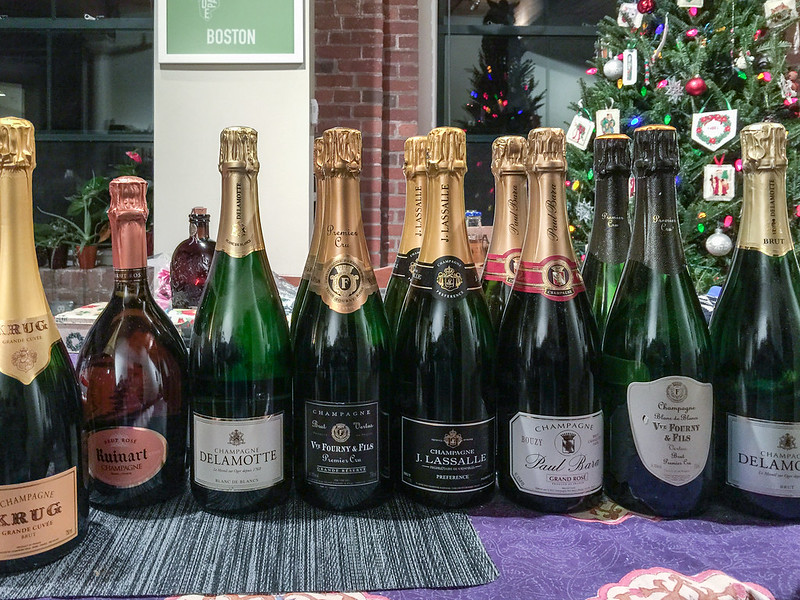Champagne
Champagne is a type of sparkling wine traditionally made in the French region of Champagne located in the northeast of the country. Some people wrongly use term champagne for every sparkling wine available.
Since 17th century it has been associated with nobility, kings and queens. It kept its special status of a beverage that is drank on special occasions until nowadays. One of such events is the New Year's Eve celebration.
 Glass of Absinthe
Glass of Absinthe
Both black (Pinot Noir and Pinot Menuier) and white (Chardonnay) grapes can be used to make a champagne. Most champagnes include up to three types of grapes. The key detail in its making is the second fermentation which results in carbonation.
A good champagne has to mature for at least three years. What follows is a process known in France as "remuage" ("riddling"). During this process bottles are moved so the remains of yeast or "lees" in the neck of the bottle can be kind of stirred.
Then the bottle or to be more precisely its neck is frozen and crown cap is removed from a bottle. Due to the pressure existing in the bottle a piece of ice containing lees gets out of the bottle and the bottle is then closed.
Champagne is usually sold in two types of bottles - those of 0.75 litres and so called "magnum" bottles of 1.5 litres. There are off course some exceptions available - "jerboam" - 3 litres, "primat" - 27 litres and "melchizedek" - 30 litres.
A cork on the bottle of champagne is covered with a wire frame called the muselet. Its purpose is to prevent the cork to fly away due to carbonated stuff inside the bottle. When opening the bottle cork flies away reaching the speed of up to 64 kilometres per hour.
There is quite an unusual way to open the bottle of champagne. It is known as the sabrage or sabering.
Usually a sommelier uses a special Champagne sabre to cut off the top of the bottle. It is believed the sabrage was first performed by the Napoleon's Hussar soldiers.
The champagne is the essential part of the victory ceremony in the formula 1 racing. The winner takes a sip and then traditionally sprays champagne towards the gathered crowd and other two guys on the victory podium. The tradition was first introduced by Dan Gurney who in 1967 won the legendary Le Mans race. As the season now includes some Islamic countries where the alcohol is banned non-alcoholic drink is there used instead. It is similar with teams whose major sponsor is from the similar country.
After finishing a new ship the bottle of champagne is traditionally broken over its hull. This is usually by some state or company official. It is sometimes considered kind of baptism or just wishing well.
Champagne is consumed slowly by swallowing only small sips. Otherwise it is possible that some unwanted troubles may occur. To much alcohol to fast can cause health problems like headache.
There are two type of glasses used to drink Champagne - a Champagne flute and Champagne coupe. Champagne flute is a narrow looking glass. inside of it one may pour between 180 and 300 ml of beverage. This type of glass can also be used for drinking beer.
Champagne coupe is of shallow appearance. It can contain between 120 and 240 ml of beverage.
As with many things in our lives there is a legend associated with it. According to this legend the shape of this glass is actually the breast belonging to the French Queen Marie Antoinette (1755-1793).
Nowadays Champagne coupe is less popular than Champagne flute. One may often see Champagne coupe type of glass when cocktails are served.
References Champagne https://en.wikipedia.org/wiki/Champagne Champagne (wine region) https://en.wikipedia.org/wiki/Champagne_%28wine_region%29 Champagne glass https://en.wikipedia.org/wiki/Champagne_glass#Champagne_flute Muselet https://en.wikipedia.org/wiki/Muselet Tim Elliot, 10 Things You Probably Didn't Know About Champagne http://honestcooking.com/10-things-you-probably-didnt-know-about-champagne/ Callan Boys, 10 things you probably didn't know about champagne http://www.goodfood.com.au/good-food/top-10-drink/10-things-you-probably-didnt-know-about-champagne-20141230-12djj1.html Sabrage https://en.wikipedia.org/wiki/Sabrage Emily Upton, Why we break a bottle of champagne against new ships http://www.todayifoundout.com/index.php/2014/02/break-bottle-champagne-new-ships/ Images Pinot noir grapes (photo by Kim Eriksson, Flickr) https://www.flickr.com/photos/kimeriksson/3942157154/ 13 bottles of Champagne (photo by Dale Cruse, Flickr) https://www.flickr.com/photos/dalecruse/15441592004/ Champagne cork (photo by Julo, Wikimedia) https://commons.wikimedia.org/wiki/File:Champagne_cork.jpg Champagne sabering (photo by Ruth Jones, Wikimedia) https://commons.wikimedia.org/wiki/File:Focused.jpg Champagne in the formula 1 racing victory ceremony (photo by Marz Photography, Flickr) https://www.flickr.com/photos/marzpiccys/2654676415/in/photostream/ Champagne flutes (photo by Didriks, Flickr) https://www.flickr.com/photos/dinnerseries/10945077084/ Champagne tower made of champagne coupe glasses (photo by Kenichi Nobusue, Flickr) https://www.flickr.com/photos/25035545@N04/2419306944